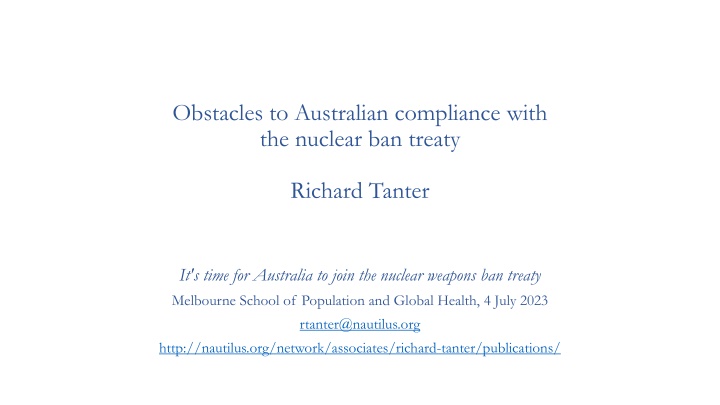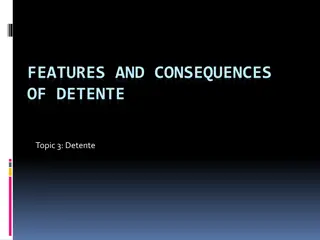Challenges to Australian Compliance with Nuclear Ban Treaty
Australia faces obstacles in complying with the UN Treaty on the Prohibition of Nuclear Weapons due to its current nuclear posture, reliance on the ANZUS alliance, and collaboration with the US in prohibited nuclear activities. The shift towards self-reliant non-nuclear defense policies is deemed necessary yet politically challenging for successful ratification.
Download Presentation

Please find below an Image/Link to download the presentation.
The content on the website is provided AS IS for your information and personal use only. It may not be sold, licensed, or shared on other websites without obtaining consent from the author.If you encounter any issues during the download, it is possible that the publisher has removed the file from their server.
You are allowed to download the files provided on this website for personal or commercial use, subject to the condition that they are used lawfully. All files are the property of their respective owners.
The content on the website is provided AS IS for your information and personal use only. It may not be sold, licensed, or shared on other websites without obtaining consent from the author.
E N D
Presentation Transcript
Obstacles to Australian compliance with the nuclear ban treaty Richard Tanter It's time for Australia to join the nuclear weapons ban treaty Melbourne School of Population and Global Health, 4 July 2023 rtanter@nautilus.org http://nautilus.org/network/associates/richard-tanter/publications/
UN Treaty on the Prohibition of Nuclear Weapons The treaty entered into force in January 2021 when the fiftieth signatory ratified the treaty as a States Party. As of July 2023 there are currently 95 signatories and 68 states parties. [See UN list here, and ICAN list here.] Article 1 prohibits: Use of nuclear weapons, and their development production, acquisition, stockpiling, retention and transfer; or assistance, encouragement or inducement of anyone to engage in any of these prohibited activities. (Article 1(e)) Article 6 specifies positive obligations for states parties, such as: ensuring the rights of victims and survivors of nuclear weapons, requiring actions to address damage to affected environments, and providing for international cooperation and assistance to meet the obligations of the instrument. 2
Australias current nuclear posture and paths to reform for compliance with the TPNW heightened ANZUS alliance integration Pre-requisite for compliance is capability to distinguish Australian national interests from those of the United States extended nuclear deterrence re prohibition on encouragement or inducement Current policy is absurd, obscene and strategically reckless Compliance requires shifting to a self-reliant non-nuclear defence policy by abandoning the extended nuclear deterrence policy - conceptually straightforward; politically difficult but feasible the joint facilities and the collaborative facilities re prohibition on assistance three joint Australian-US facilities involved in activities prohibited under the TPNW through U.S nuclear command, control, communications and intelligence (NC3I) (government list) Joint Defence Facility Pine Gap, Alice Springs (signals intelligence interception and missile launch surveillance) Harold E. Holt Naval Communications Station, North West Cape (US nuclear-armed ballistic missile submarine communications) Joint Geological and Geophysical Research Station, Alice Springs, (nuclear detonation seismic detection) There are other collaborative facilities also possibly conducting prohibited activities, through either joint extended nuclear deterrence operations or NC3I activities RAAF Bases Darwin, Tindal and Amberley (current or planned deployment of U.S B-52 nuclear-capable and B-2 dual- capable bombers) Space Surveillance Telescope and Space Surveillance Radar, North West Cape (NC3I assistance) 3
How much compliance with the TPNW over assistance is in fact required for successful ratification, and who decides? Looking at all these possible and complex links to prohibited activities under the TPNW, the questions arise how much compliance with the TPNW is in fact required for successful ratification? Who will decide? Lawyers will probably say complete or comprehensive compliance in all respects. ICAN would always be concerned that a nuclear-umbrella country closely allied to a nuclear weapons state may seek to use partial compliance as a pathway to white-anting of the treaty regime. My guess is that no court will ever be involved; the TPNW Meeting of the Parties will decide case by case; The MoP will do so on the basis of judgements in specific cases about sufficient and appropriate to achieve the primary goals of the treaty and to avoid potential white-anting; and that since there will always be substantial elements of secrecy and lack of reliable knowledge about NC3I systems in particular that an MoP may well make a pragmatic decision to require vitiation of the most egregious and direct violations of prohibited assistance .
Pine Gaps big ears and big infrared eyes: three distinct functions today 1. Control and processing station for US satellites conducting space-based signals intelligence (SIGINT) collection of a wide range of electronic transmissions 2. Processing station for ground-based interception of foreign communications satellite transmissions 3. Relay Ground Station for US early warning infrared surveillance satellites 5
The hard case for the TPNW: Pine Gaps nuclear weapons roles 1. Nuclear attack planning support: Pine Gap s big ears in space and on the ground providing the locations and characteristics of enemy operational units, radars and air defences; and collaboration in tracking mobile ICBMs and missile submarines at sea. 2. Early warning: its infrared satellites detecting enemy nuclear missile launches, giving the US a few minutes of warning of nuclear attack 3. Nuclear second strike targeting support: detects which enemy missile silos (and submarines) have been fired and which have not, and are therefore to be targeted in a US second nuclear strike. 4. Missile defence: when Pine Gap detects the first seconds of missile launches and calculates the missiles likely trajectories, it passes the information to the US missile defence systems, cueing their fire radars to search a tiny portion of the sky where the missiles are gathering enormous speed. Cued by Pine Gap, and if they work as the Pentagon and the arms manufacturers advertise, US missile defences might, just might have a chance of firing their own missiles to hit and destroy the enemy missiles. 5. Verification of certain arms control agreements by detecting infrared characteristics of adversary test missiles. 6
Australian government position due to the number and complexity of nuclear weapons connections, it s too hard to comply Australian government position (Richard Sadleir, Assist. Sec., DFAT, Senate estimates, 31 May 2018) stated that the many separate interlocking structures, understandings, agreements and joint activities and facilities at the joint facilities are incompatible with the treaty; and that it is impossible, not practical, for Australia to restrict roles under the alliance to non-nuclear missions, including deterrence alone . Implications of government position the government recognizes Australian complicity in preparations for nuclear war-fighting (aka US policy to fight and win a nuclear war), i.e. we are involved in more than stable nuclear deterrence . It s all too hard to think about : Half a century of Australian nuclear weapons cooperation with US for both nuclear deterrence and nuclear war- fighting has built up to a point where even the government believes it cannot separate nuclear and non-nuclear elements of the bases. Australian citizens have never been told of this by any government, but should give up on reform of Pine Gap to comply with the TPNW In fact, in the most important aspect of Pine Gap for the TPNW, the government s claims that the nuclear and non-nuclear elements of assistance are inseparable are disingenuous and intellectually lazy.
RGS 2014 8
Pine Gap is the obvious test case of the governments disingenuous and intellectually lazy It s all too hard position. A careful examination of precisely what Pine Gap does shows there is a viable pathway for Australia to become compliant with the TPNW without disrupting its alliance with the United States. The Relay Ground Station links to US early warning satellites with infrared sensors detecting the launch of enemy missiles. The infrared detection satellites that provide early warning of an attack are also essential for US nuclear war fighting. The same technology that detects the heat blooms of missile launches also indicates which known adversary nuclear missile sites are empty following firing, and which remain capable of firing. the Relay Ground Station is an automatically operated and remotely controlled station that is technically redundant. If the Australian government gave the United States notice say five years the Relay Ground Station could be closed without significant detriment to US national interests. The rest of Pine Gap the much larger signals intelligence facility would remain untouched. 9
What is the Relay Ground Stations nuclear targeting connection? Why does technological change mean the Relay Ground Station can be closed without damaging the US alliance? The infrared detection satellites that provide early warning of an attack are also essential for US nuclear war fighting. The same technology that detects the heat blooms of missile launches also indicates which known adversary nuclear missile sites are empty following firing, and which remain capable of firing. This is critical data for compiling the list of locations to target for a US retaliatory strike. the Relay Ground Station is technically redundant. For almost half a century the US has been worried that intelligence satellite ground stations that provide command and control for satellites are highly vulnerable to nuclear missile attack - like Pine Gap. US early warning satellites are now are built with multiple means of communicating with the Mission Control Station in the US, apart from Pine Gap s bent pipe : satellite-to-satellite crosslinks satellite links to relay satellites satellite links to mobile ground stations in US theatre commands If the Australian government gave the United States notice say five years the Relay Ground Station could be closed without significant detriment to US national interests. The rest of Pine Gap the much larger signals intelligence facility would remain untouched. 10
A new problem for compliance with the TPNW: RAAF Base Tindal dedicated USAF facilities at for B-52 fly-in fly-out aircraft Announced plan for rotational deployment of B-52H strategic bombers to Tindal $1.5 billion upgrading and expansion of Tindal infrastructure to support B-52 deployment and operations - USAF bomber apron, operations facility, bomb storage facilities, fuel farm, personnel facilities, maintenance facility B-52s home-based in US in two versions non-nuclear only, and nuclear-capable. Both have regularly visited Australia Under Treaty of Rarotonga, the South Pacific NWFZ prohibits stationing of nuclear weapons in Australia, but permits transits and visits (undefined). The Albanese government has declared respect for and understanding of US policy to neither confirm nor deny the presence of nuclear weapons on board US aircraft entering Australia. As a consequence, the Australian government cannot know if nuclear-armed B-52s will be part of rotational deployment to Tindal The government has refused to declare that no nuclear-capable versions will come to Tindal.
RAAF Base Tindal US-Australia Force Posture Initiative expansion Sources: Google Earth, 5 November 2022; Submission 1. Department of Defence, RAAF Base Tindal Redevelopment Stage 6 and United States Force Posture Initiatives Airfield Works, Parliament of Australia, Standing Committee on Public Works, 2020; Industry Capability Network, EST00346 TDL Redev / EST00347 KC-30A Facilities, Work Package: Invitation to Register (ITR) Brief, Project Registration Form, EST00346 RAAF Base Tindal Redevelopment Stage 6 and EST00347, US Force Posture Initiatives (USFPI) RAAF Base Tindal Airfield, Works and Associated Infrastructure, [accessed 14 May 2023]; Ashley Townsend/@ashleytownshend, There's nothing new about B-52s deploying to Australia , Twitter, 31 October 2022.
Nuclear-capable B-52s to Tindal strategic and compliance implications Nuclear-capable B-52H aircraft can be armed with up to 20 AGM-86B Air-Launched Cruise Missiles, each of which carries a W80-1 nuclear warhead, with a low to intermediate variable yield of 5 to 150 kilotons. Important strategic drive to host US bomber base less vulnerable to Chinese attack than Guam and Diego Garcia Co-development of infrastructure with Australia, which will supply more refueling tankers, fighter protection, and airborne early warning and control aircraft for B-52 operations Australian agreement to shared deterrence doctrine and operations, and Australian commentators applaud the B-52 deployment as giving Australia agency and sovereignty , and rejecting artificial distinction between conventional and nuclear weapons Important contrast to the Fraser government s 1981 agreement to allow B-52 training overflights and staging through RAAF Base Darwin on the basis that: No B-52s over Australia would be armed, nuclear or otherwise Australia has a firm policy that aircraft carrying nuclear weapons will not be allowed to fly over or stage through Australia without its prior knowledge and agreement Specified a need to know...whether nuclear weapons are being carried as a precondition to approving any new agreement in B-52 operations The solutions: reject US neither confirm nor deny doctrine (militarily useless), and remove the section in the Australian enabling act for the Treaty of Rarotonga that permits nuclear-armed aircraft to enter.
For detailed documentation and argument relevant to this presentation see RT papers here Imagining the Possible: Asia-Pacific Prospects for the Nuclear Ban Treaty , GlobalAsia, Vol.16 No. 2, (June 2021), pp. 48-51. Hope Becomes Law: The Treaty on the Prohibition of Nuclear Weapons in the Asia-Pacific Region , Journal for Peace and Nuclear Disarmament, Vol. 4, (2021), Supplement 1, pp. 234-275, DOI: 10.1080/25751654.2021.1908736 Hiding from the light: The establishment of the Joint Australia-United States Relay Ground Station at Pine Gap, Special Report, Nautilus Institute for Security and Sustainability, 2 November 2019 An Australian pathway through Pine Gap to the nuclear ban treaty , Pearls & Irritations, 5 August 2019; Alice Springs News, 6 August 2019; [extended and footnoted version here]. Tightly Bound: Australia s Alliance-Dependent Militarization , Global Asia, Spring 2018, Vol.13 No.1; extended and documented version: Tightly Bound: The United States and Australia s Alliance-Dependent Militarization , Asia-Pacific Journal, Volume 16, Issue 11, Number 2 (31 May 2018) WikiLeaks, Australia and empire , in Felicity Ruby and Peter Cronau, (eds.), A Secret Australia: Revealed by the WikiLeaks Expos s, Monash University Publishing, 2020. 14
Compliance with the TPNW: the future of the joint facilities? On May 31 On May 31st st, 2018, Richard Sadleir, a DFAT assistant secretary t , 2018, Richard Sadleir, a DFAT assistant secretary told a Senate estimates hearing would be impossible , because the nuclear elements of activities at the joint facilities are now too densely interwoven with the non-nuclear elements that they cannot be separated. old a Senate estimates hearing that that joining the treaty The joint facilities The joint facilities a.k.a. Australia control and intelligence control and intelligence are, Sadleir, argued, made up of many separate interlocking structures, understandings, are, Sadleir, argued, made up of many separate interlocking structures, understandings, agreements and joint activities and facilities that are incompatible with the treaty , and that it is impossible, not agreements and joint activities and facilities that are incompatible with the treaty , and that it is impossible, not practical, for Australia to restrict roles under the alliance to non practical, for Australia to restrict roles under the alliance to non- -nuclear missions. a.k.a. Australia- -located elements of the U.S. globally distributed systems of nuclear command, located elements of the U.S. globally distributed systems of nuclear command, nuclear missions. Sadleir gave two examples of joint facilities incompatible with the treaty, where the nuclear-related functions could not be separated from non-nuclear missions , both near Alice Springs: the Joint Defence Facility Pine Gap Joint Defence Facility Pine Gap; and the Joint Geological and Geophysical Research Station Joint Geological and Geophysical Research Station Sadleir did not mention a third joint facility, the Harold E Holt Naval Communications Station at North West Cape Harold E Holt Naval Communications Station at North West Cape in Western Australia, with an important role in U.S. nuclear command and control undoubtedly not compatible with the prohibition on assistance to nuclear weapons operations. Source: Statement by DFAT Assistant Secretary Richard Sadleir, Senate, Foreign Affairs, Defence and Trade Legislation Committee, Parliament of Australia, Estimates Hearing, (31 May 2018), page 215. See also the follow-up answer supplied by Senator Marise Payne, Minister for Foreign Affairs, Question on notice no. 11. Portfolio question number: 11. 2018-19 Budget estimates, Foreign Affairs, Defence and Trade Committee, Foreign Affairs and Trade Portfolio, File name: FADT Q0011_Answered 2018_07_13. 16
What is the Relay Ground Stations nuclear targeting connection? Why does technological change mean the Relay Ground Station can be closed without damaging the US alliance? The infrared detection satellites that provide early warning of an attack are also essential for US nuclear war fighting. The same technology that detects the heat blooms of missile launches also indicates which known adversary nuclear missile sites are empty following firing, and which remain capable of firing. This is critical data for compiling the list of locations to target for a US retaliatory strike. the Relay Ground Station is technically redundant. For almost half a century the US has been worried that intelligence satellite ground stations that provide command and control for satellites are highly vulnerable to nuclear missile attack - like Pine Gap. US early warning satellites are now are built with multiple means of communicating with the Mission Control Station in the US, apart from Pine Gap s bent pipe : satellite-to-satellite crosslinks satellite links to relay satellites satellite links to mobile ground stations in US theatre commands If the Australian government gave the United States notice say five years the Relay Ground Station could be closed without significant detriment to US national interests. The rest of Pine Gap the much larger signals intelligence facility would remain untouched. 17
Three bases, three different problems, three areas of doubt, three solutions These three examples of joint facilities cited by the government that may be incompatible with obligations under Article 1 of the TPNW in fact raise different issues, and require different solutions for Australia to become compliant with the TPNW: the Joint Defence Facility Pine Gap (JDFPG) the Joint Geological and Geophysical Research Station (JGGRS) the Harold E Holt Naval Communications Station (HEH NCS) at North West Cape These are three of the oldest US facilities in Australia, dating back three-quarters of a century 1954 - in the case of the JGGRS, 1962 for HEH NCS, and 1966 for JDFG. In brief, compliance with the TPNW for these three bases requires: Closure of U.S. access to the Very Low Frequency submarine communications station at North West Cape, cutting off any Australian role in communication of U.S. nuclear-attack orders to nuclear missile submarines GeoScience Australia to take over full responsibility, staffing, budget and operation of the nuclear detonation and earthquake seismic monitoring station at the JGGRS from the current position of nominal joint but in fact de facto sole U.S. Air Force - control, and commit the station solely to use for Australian and CTBT International Monitoring System seismic monitoring use. Giving notice to the U.S. of intention to close the Relay Ground Station at Pine Gap that automatically relays data to U.S. control stations from U.S. infrared early warning satellites including nuclear second strike targeting data, and to replace communication of data from those satellites to their U.S. control station through the RGS by existing satellite-to-satellite communications cross-links. 18
Global structures of accountability for war, nuclear terror, and planetary climate security: Global structures of accountability for war, nuclear terror, and planetary climate security: Cross Cross- -national processes of democratic control national processes of democratic control a missing element of democratic global governance governance a missing element of democratic global In Australian discussions of the asymmetries of alliance, questions of national sovereignty must be central, with the aim of maintaining democratic policy-formation at a national level. But WikiLeaks revelations point beyond maintaining an adequate level of national sovereignty to the need to establish cross-national processes of democratic control a missing element of democratic global governance relevant to multinational institutions of truly global reach and deep penetration into the political cultures of national democratic polities. Life under empire involves both our inner and outer lives, and WikiLeaks has become an icon of global resistance to empire, and as such has provoked deep and irrational resistance in turn. In psychoanalytic terms, Jacqueline Rose says, Resistance is blindness the strongest weapon or bluntest instrument the mind has at its disposal against the painful, hidden, knowledge of the unconscious . [Jacqueline Rose, The Last Resistance, Verso, 2007, p. 19.] Richard Tanter, WikiLeaks, Australia and empire , in Felicity Ruby and Peter Cronau, (eds.), A Secret Australia: Revealed by the WikiLeaks Expos s, Monash University Publishing, 2020, p. 38 19























